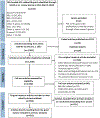Data Velocity in HIV-Related Implementation Research: Estimating Time From Funding to Publication
- PMID: 35703753
- PMCID: PMC9204847
- DOI: 10.1097/QAI.0000000000002963
Data Velocity in HIV-Related Implementation Research: Estimating Time From Funding to Publication
Abstract
Background: Given available effective biomedical and behavioral prevention and treatment interventions, HIV-related implementation research (IR) is expanding. The rapid generation and dissemination of IR to inform guidelines and practice has the potential to optimize the impact of the Ending the Epidemic Initiative and the HIV pandemic response more broadly.
Methods: We leveraged a prior mapping review of NIH-funded awards in HIV and IR from January 2013 to March 2018 and identified all publications linked to those grants in NIH RePORTER through January 1, 2021 (n = 1509). Deduplication and screening of nonoriginal research reduced the count to 1032 articles, of which 952 were eligible and included in this review. Publication volume and timing were summarized; Kaplan-Meier plots estimated time to publication.
Results: Among the 215 NIH-funded IR-related awards, 127 of 215 (59%) published original research directly related to the grant, averaging 2.0 articles (SD: 3.3) per award, largely in the early IR phases. Many articles (521 of 952, 55%) attributed to grants did not report grant-related data. Time from article submission to publication averaged 205 days (SD: 107). The median time-to-first publication from funding start was 4 years. Data dissemination velocity varied by award type, trending toward faster publication in recent years. Delays in data velocity included (1) time from funding to enrollment, (2) enrollment length, and (3) time from data collection completion to publication.
Conclusion: Research publication was high overall, and time-to-publication is accelerating; however, over 40% of grants have yet to publish findings from grant-related data. Addressing bottlenecks in the production and dissemination of HIV-related IR would reinforce its programmatic and policy relevance in the HIV response.
Copyright © 2022 Wolters Kluwer Health, Inc. All rights reserved.
Conflict of interest statement
E.G. has received non–drug-related funding from ViiV healthcare. The remaining authors have no conflicts of interest to disclose.
Figures




References
-
- Baral S, Rao A, Sullivan P, et al. The disconnect between individual-level and population-level HIV prevention benefits of antiretroviral treatment. The lancet HIV. 2019. - PubMed
Publication types
MeSH terms
Grants and funding
LinkOut - more resources
Full Text Sources
Medical

